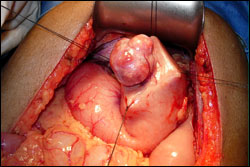- No products in the cart.
Institute Of
Gastroenterology
Gastric Surgery
Gastric bypass surgery is undergone on people who are morbidly obese. Obesity occurs when a person is unable to maintain weight loss not following a proper healthy diet and is also suffering from comorbid diseases. It can be life-threatening and have a negative impact on an individual’s quality of life. The process begins with the stomach being separated into two pouches, one small and one large, and the small intestine being positioned to link to both. The general term used for surgeries for morbid obesity is bariatric surgery. While surgery it will be painless since it is done general anesthesia. Gastric bypass surgery can be divided into three categories:
Gastric by-pass Roux en-Y (proximal)
The small intestine is separated 45 cm below the lower stomach in this procedure. It is then placed at a Y intersection in the small intestine’s proximal end, allowing food to exit via a Roux limb.
Gastric by-pass Roux en-Y (distal)
The Y intersection with this approach is at the distal end of the small intestine. Fats and starches are absorbed less efficiently and are passed to the large intestine.
Mini gastric bypass
MGB is a less invasive treatment that is still relatively new. The stomach is separated from the esophagus. The stomach’s separated part is stapled and stitched. A new, smaller section of the stomach is linked to the bypassed intestine, which is about 2 to 7 feet long. This little stomach now receives the food and continues the digestion process through the rest of the intestines.
Gastric band surgery
The gastric banding operation decreases the stomach’s capacity with the help of a band. In the upper stomach, a tiny pouch is formed that can hold a minimal amount of food. It’s a gastric band with an inflated circular balloon that may be adjusted. The pouch fills up while you eat, and the band restricts the passage of food into the lower stomach
Gastric sleeve surgery
Gastric sleeve surgery can be operated as an open or laparoscopic procedure. The stomach is removed in its entirety, leaving just a tube-shaped gastric sleeve. Surgical staples are used to seal the gap in the stomach.
Surgery for gastric ulcer
Peptic ulcers are caused by Helicobacter Pylori. Severe upper abdominal discomfort and vomiting are symptoms of a big gastric ulcer in the stomach lining. Medication is frequently used to treat these ulcers. These ulcers can bleed vastly requiring transfusion of blood and now and again surgery. Surgery for ulcers can be a form of partial gastrectomy called Gastric Surgeries.
Surgery for duodenal ulcer
Duodenal ulcers can result in bleeding or a blockage of the gastric outlet, resulting in chronic vomiting. The stomach’s contents are drained through an anastomosis between the stomach and the proximal loop. The surgery for this condition will be a gastro-jejunostomy and a truncal vagotomy.
Surgery for cancer of the stomach
Stomach cancer is a highly common disease in southern India. Stomach cancer manifests as a malignant growth that grows in the stomach. Gastric cancer is another name for stomach cancer. These patients can present with a variety of symptoms, including weight loss, abdominal pain, vomiting, or sometimes no symptoms at all. A diagnostic upper GI endoscopy is frequently required. Stomach cancer will most likely necessitate surgery in the form of a partial, whole, or bypass gastrectomy, followed by chemotherapy if necessary.
Surgery for corrosive injury of the stomach
Acid injury to the stomach caused by inadvertent or suicidal consumption of bathroom acid causes significant damage to the stomach, necessitating emergency or elective stomach surgery such as Bypass Gastric Surgery.
Gastric Sleeve Surgery
Hiatus hernia fundoplication severe heartburn caused by a hiatus hernia may necessitate surgical therapy in the form of a fundoplication, which involves reconstructing a new valve at the junction between the food pipe and stomach.



